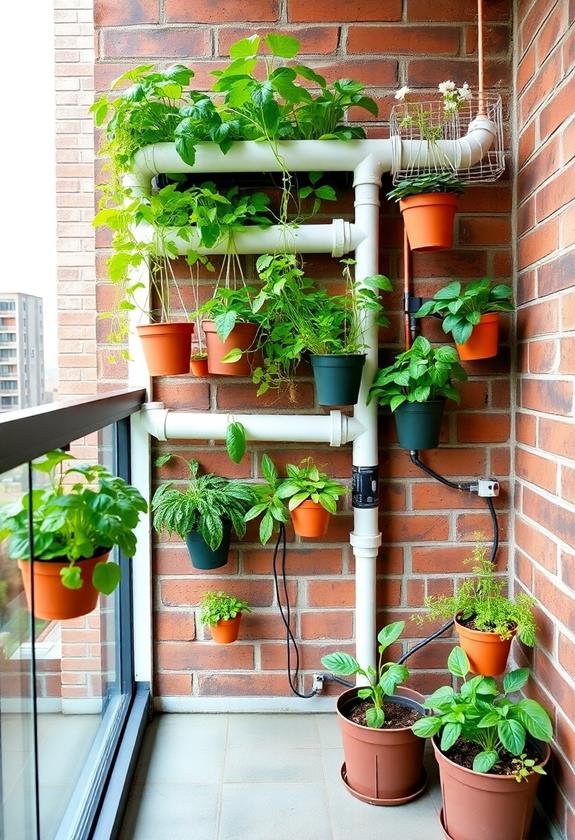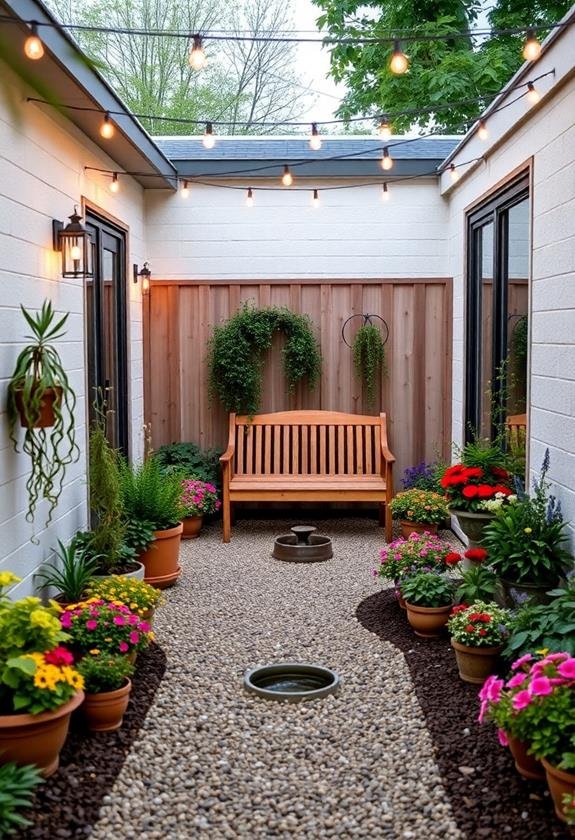Vertical gardens are your ticket to a lush, productive backyard, no matter how small! You’ll maximize every inch of space while creating a stunning living wall. Start by evaluating your sunlight and selecting the right plants—think herbs, succulents, or cascading flowers. DIY options abound: upcycle pallets, repurpose shoe organizers, or create tiered planter stands. Don’t forget sturdy supports and well-draining soil. With regular watering, pruning, and a dash of fertilizer, you’ll soon have a thriving vertical oasis. I’ve transformed my tiny patio into a green haven, and you can too! The possibilities are endless when you think vertically.
Key Takeaways
- Utilize vertical space with structures like pallets, trellises, or tiered planters to maximize gardening area in small backyards.
- Choose compact, drought-resistant plants suitable for vertical growth, such as succulents, herbs, and trailing varieties.
- Implement efficient watering systems, like drip irrigation, to ensure consistent moisture for vertically arranged plants.
- Upcycle common household items into vertical planters, such as shoe organizers for herbs or gutters for small vegetables.
- Plan your vertical garden based on sunlight exposure, plant needs, and your goals for aesthetics or food production.
Benefits of Vertical Gardening

Vertical gardening offers three key benefits that make it an attractive option for both novice and experienced gardeners.
First, it’s a space-saver extraordinaire! You’ll be amazed at how much you can grow in a tiny footprint. I once turned a drab apartment balcony into a lush oasis using just a few wall-mounted planters.
Secondly, vertical gardens are a feast for the eyes. They add visual interest and depth to any outdoor area, transforming blank walls into living works of art. Trust me, your neighbors will be green with envy!
Lastly, these gardens are incredibly versatile. You can grow:
- Herbs for your kitchen
- Flowers for pollinators
- Vegetables for farm-to-table meals
Plus, they’re perfect for urban environments where ground space is at a premium. You’ll enjoy better air quality, reduced noise pollution, and even lower energy bills as your plants provide natural insulation.
Ready to get started? Here’s a quick tip: Begin with low-maintenance plants like succulents or trailing vines. As you gain confidence, you can experiment with more challenging varieties.
Happy vertical gardening!
Planning Your Vertical Garden

Now that you’re sold on the idea of vertical gardening, let’s get down to brass tacks. Planning your vertical garden is essential for success, and I’ve learned this the hard way!
First, assess your space. Is it sunny or shady? Wind-protected or exposed? These factors will influence your plant choices and structure needs. Consider implementing stackable planters to maximize your vertical space and accommodate various plant types. These versatile solutions often come with built-in drainage systems, making them ideal for small backyards.
Next, consider your goals:
- Aesthetic appeal
- Food production
- Privacy screening
- Combination of the above
Once you’ve nailed down your objectives, it’s time to choose your structure. From DIY pallet gardens to fancy modular systems, the options are endless! I once created a vertical herb garden using old rain gutters – talk about resourceful!
Now, let’s talk soil and irrigation. You’ll need a well-draining potting mix and a reliable watering system. Trust me, hauling a watering can up a ladder gets old fast!
Finally, select your plants. Consider:
- Growth habits (trailing vs. upright)
- Root depth requirements
- Seasonal changes
Materials and Tools Needed

Every successful vertical garden starts with the right materials and tools. You’ll need a sturdy structure to support your plants, whether it’s a premade frame or a DIY creation using pallets or trellises.
Don’t forget about containers or pockets to hold your plants and soil. I once tried using old shoe organizers, and they worked surprisingly well!
When it comes to tools, you’ll want to have these essentials on hand:
- Garden trowel for planting and soil work
- Pruning shears to keep your plants tidy
- Watering can or hose with a spray nozzle
- Gloves to protect your hands
Remember, the type of plants you choose will influence your material needs. Succulents, for instance, require well-draining soil and shallow containers, while herbs might need deeper pots.
I learned this the hard way when my first vertical herb garden quickly became root-bound!
For mounting your garden, gather screws, brackets, and a drill. If you’re using a fabric pocket system, heavy-duty staples and a staple gun will be your best friends.
Trust me, you don’t want your hard work tumbling down mid-season!
Simple DIY Vertical Garden Ideas

With the right materials in hand, you’re ready to plunge into creating your own vertical garden.
Let’s explore some simple, yet stunning ideas that’ll transform your small backyard into a lush oasis.
- Pallet Garden:
- Upcycle an old wooden pallet
- Sand it down, add a backing, and paint it
- Fill with soil and plant herbs or succulents
- Hanging Pocket Organizer:
- Repurpose a shoe organizer
- Hang it on a fence or wall
- Perfect for small plants and herbs
- Tiered Planter Stand:
- Build or buy a multi-level stand
- Place pots of varying sizes on each level
- Create a cascading effect with trailing plants
- Gutter Garden:
- Mount rain gutters on a fence or wall
- Drill drainage holes and fill with soil
- Ideal for growing lettuce or strawberries
I once created a vertical herb garden using old tin cans.
It was a hit at my summer BBQs – guests loved picking fresh basil for their drinks!
Remember, vertical gardening is all about creativity and maximizing space.
Don’t be afraid to experiment with different containers and plant combinations.
Plant Selection for Vertical Gardens

Once you’ve chosen your vertical garden structure, selecting the right plants is key to its success.
You’ll want to take into account factors like sunlight exposure, water needs, and root depth. I’ve found that mixing different textures and colors creates a visually stunning display.
Remember, not all plants are suited for vertical growth!
Here are some great options to take into account:
- Succulents: These low-maintenance beauties are perfect for sunny spots and don’t need much water.
- Herbs: Basil, thyme, and oregano thrive in vertical gardens and provide fresh flavors for your cooking.
- Ferns: They add lush, green texture and do well in shadier areas.
- Trailing plants: Ivy, pothos, and string of pearls create a cascading effect that’s simply gorgeous.
When I first started my vertical garden, I made the mistake of using plants with deep root systems.
Trust me, it’s not fun trying to squeeze them into shallow pockets! Stick to shallow-rooted plants for best results.
Don’t forget to take into account your climate and the amount of time you can dedicate to maintenance.
With the right plant selection, your vertical garden will be the envy of the neighborhood!
Maintenance and Care Tips

Keeping your vertical garden thriving requires regular attention and care. Trust me, I’ve learned this the hard way! Here are some key maintenance tips to keep your green wall looking lush:
- Watering: It’s essential to get this right.
- Check soil moisture daily, especially in hot weather.
- Water thoroughly, but don’t oversaturate.
- Consider installing a drip irrigation system for convenience.
- Fertilizing:
- Use a balanced, water-soluble fertilizer every 2-4 weeks.
- Adjust frequency based on plant needs and season.
- Pruning and Trimming:
- Regularly remove dead or yellowing leaves.
- Pinch back growth to encourage bushiness.
- Keep vining plants in check to prevent overcrowding.
- Pest Control:
- Inspect plants weekly for signs of pests or disease.
- Use organic pest control methods when possible.
- Rotation:
- Rotate plants occasionally to guarantee even sun exposure.
I once neglected my vertical herb garden for a week, and it looked like a wilted mess!
But with consistent care, it bounced back beautifully.
Overcoming Common Challenges

While proper maintenance sets the foundation for a thriving vertical garden, you’ll likely encounter some hurdles along the way.
As someone who’s weathered many gardening storms, I can guarantee you that these challenges are part of the journey.
Let’s tackle some common issues head-on!
1. Uneven watering: I’ve learned the hard way that top plants often get too much water, while lower ones stay dry.
Try installing a drip irrigation system or use self-watering planters to guarantee even moisture distribution.
2. Plant selection mistakes: Not all plants thrive vertically!
Stick to compact, lightweight varieties like herbs, succulents, and trailing plants.
3. Soil erosion: This pesky problem can leave roots exposed.
Combat it by adding a layer of mulch or using coconut coir liners to hold soil in place.
4. Pest infestations: Vertical gardens can be pest magnets.
Introduce beneficial insects like ladybugs or use neem oil spray as a natural deterrent.
Frequently Asked Questions
Can Vertical Gardens Be Installed on Apartment Balconies or Rental Properties?
You can install vertical gardens on apartment balconies and rental properties.
They’re perfect for small spaces and can add a splash of green to your outdoor area. Just be sure to check with your landlord first, as some may have restrictions.
I’ve had great success with hanging pocket planters and tiered shelving units. They’re easy to set up, maintain, and even move when needed.
Plus, you’ll love having fresh herbs or flowers right outside your door!
How Do Vertical Gardens Affect the Structural Integrity of Walls or Fences?
You’d be amazed at how vertical gardens can transform walls, but let’s talk structure!
While they’re not skyscrapers, these green beauties can add some weight. You’ll want to guarantee your wall or fence is sturdy enough to handle the load.
I’ve seen a neighbor’s flimsy fence bow under the weight – oops!
Pro tip: use lightweight materials, distribute weight evenly, and check for moisture damage regularly.
With proper planning, you’ll have a gorgeous, structurally sound vertical garden in no time!
Are There Any Specific Permits Required for Installing Vertical Gardens?
You’ll be glad to know that in most cases, you don’t need specific permits for vertical gardens.
However, it’s always smart to check with your local zoning office or homeowners’ association. I once installed a vertical garden without checking, and luckily, I was in the clear!
If you’re planning a large-scale installation or modifying existing structures, you might need approval.
Remember, it’s better to ask first than face fines later.
Happy gardening, and enjoy your green wall!
Can Vertical Gardens Be Used to Grow Vegetables and Herbs Year-Round?
You can grow veggies and herbs year-round in vertical gardens, but it’ll take some planning.
I’ve had great success with leafy greens and compact herbs in mine. Here’s the scoop:
- Choose cold-hardy varieties for winter
- Use frost protection (like mini greenhouses) in colder months
- Rotate crops seasonally
- Guarantee proper lighting (supplemental grow lights might be needed)
- Monitor water and nutrients closely
Remember, some plants will thrive better than others depending on your climate.
It’s a fun experiment – give it a try!
What Are the Best Ways to Protect Vertical Gardens From Extreme Weather?
You’re enthusiastic to protect your vertical garden, aren’t you? Well, here’s the scoop: Start by installing sturdy trellises or supports to withstand wind.
Next, use frost cloths or plastic sheeting for cold snaps. Don’t forget shade cloth for scorching days!
I’ve found that strategically placing your garden near walls or fences can provide natural shelter.
Finally, consider a retractable awning for quick coverage.
With these tips, your vertical garden will weather any storm – trust me, I’ve been there!
Conclusion
You’re now ready to transform your small backyard into a lush, vertical oasis! Remember, Rome wasn’t built in a day, and neither will your garden be. But with patience, creativity, and a bit of elbow grease, you’ll soon be enjoying a beautiful, space-efficient garden that’s the envy of the neighborhood. So roll up your sleeves, grab those tools, and let your imagination climb to new heights. Your vertical gardening adventure awaits!




